The next and most interesting step in my bread-baking education was to build my own sourdough starter. Given that I would be trying to create a breeding ground for bacteria, something ordinarily staunchly avoided in cooking, I have to admit to a bit of trepidation. But folks have been doing it for ages, and the process is really fairly easy, so before we left for the holidays, I set about building a sourdough starter following the steps laid out by Peter Reinhart in The Bread Baker’s Apprentice.
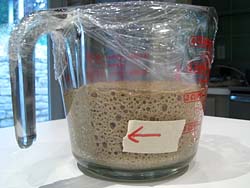 Day one began easily enough. I simply mixed together rye flour and water, left it to sit at room temperature for 24 hours, and let nature take its course. My understanding is that a nice organic rye flour has wild yeasts living in and among it. All you need to do is create good growing conditions for those yeasts and you’ll eventually be rewarded with a nice wild starter. Reinhart warns that there shouldn’t be much activity on that first day, however, my little culture had already doubled in size. I don’t know exactly why this happened, however, my best guess is that perhaps the water I added was a bit warmer than it should have been and it allowed for a more pleasantly habitable environment for the yeasts allowing them to reproduce more rapidly than if I had added cooler water. I suppose it’s also possible that my rye flour was simply more heavily yeasted than other rye flours (if you’re curious, I used Arrowhead Mills Organic Rye Flour). Then again, the fabulous Mr. Reinhart has another potential answer to my question here (though I saw no mold).
Day one began easily enough. I simply mixed together rye flour and water, left it to sit at room temperature for 24 hours, and let nature take its course. My understanding is that a nice organic rye flour has wild yeasts living in and among it. All you need to do is create good growing conditions for those yeasts and you’ll eventually be rewarded with a nice wild starter. Reinhart warns that there shouldn’t be much activity on that first day, however, my little culture had already doubled in size. I don’t know exactly why this happened, however, my best guess is that perhaps the water I added was a bit warmer than it should have been and it allowed for a more pleasantly habitable environment for the yeasts allowing them to reproduce more rapidly than if I had added cooler water. I suppose it’s also possible that my rye flour was simply more heavily yeasted than other rye flours (if you’re curious, I used Arrowhead Mills Organic Rye Flour). Then again, the fabulous Mr. Reinhart has another potential answer to my question here (though I saw no mold).
Day two was equally simple. To the original culture, I added some unbleached high-gluten flour (I just used King Arthur brand) and some water, mixed it up, and again let it sit. My yeasts continued to thrive. In fact, my seed culture went so berzerk that it threatened to ooze out of its container. Said another way, it more than tripled in size over the course of 24 hours. Reinhart said that I should have maybe seen a 50% rise. Also, the smell was pretty off-putting at this point (though it’s supposed to be). This is where I had considered starting over, but eventually decided to instead see it through to the end.
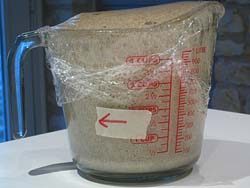
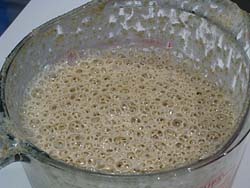
Day three was anticlimactic. I discarded half the mixture and augmented the remainder with another dose of water and unbleached high-gluten flour. After 24 hours, I checked for a rise and was surprised to find that it had barely risen at all (here’s where Reinhart expected to see it doubling). The smell, however, had gone from disgusting to brightly sour – my bacteria were growing!
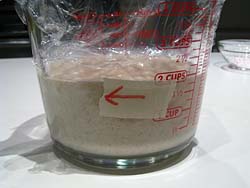
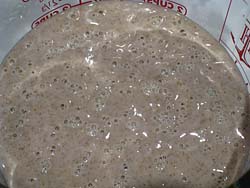
On day four, I stopped taking pictures and went into troubleshooting mode. Once the mixture has doubled in size, you repeat the day three procedure of removing half the mixture and then adding in more unbleached high-gluten flour and water and wait a few hours for it to double. However, mine wasn’t doubling. I wondered if the bacteria had decimated the yeast. That’s not how it’s supposed to work. The reason you cultivate wild yeast isn’t because they themselves are sour. It is because the only yeast that will survive the cultivation of the necessary bacteria to produce sourness are wild yeasts. My yeasts had gotten lethargic. My solution was to add in a couple tablespoons of the rye flour to reintroduce a bit more yeast to the party. I let it rest till it doubled in size. Then I carried out the day four procedure on day five. After a few overnight hours of happy fermenting, I had a bubbly, gloriously pungent sourdough seed culture. (Incidentally, if you don’t want to go to the trouble of building your own seed culture, sourdough starter can be purchased from the likes of King Arther Flour.)
The next step was to create the barm. The barm is what I’d be keeping in the refrigerator and routinely refreshing and eventually be naming if it lived long enough. The barm is simply a mixture of the seed culture and a large dose of unbleached high-gluten flour and water. This is allowed to ferment at room temperature till it’s good and bubbly, then it is placed in the refrigerator overnight to slow the ferment but to allow flavors to continue to develop. I bet you think I’ve forgotten about the rest of my hard-won seed culture. Nope, I’ve simply discarded it. Assuming I don’t kill my barm, I’ve no need of new seed culture for a while.
The next day, I converted a small portion of my barm to starter (this is day seven for those keeping track). For the Basic Sourdough Bread I was intending to make, I would need only about 2/3 cup of my 6 or so cups of barm (the rest remained in the refrigerator where it can theoretically be kept in an airtight container for up to two months). This was mixed with more water and unbleached high-gluten flour and allowed to ferment until it doubled (about 6 hours for me, which is actually little long). Then the starter was mixed with more flour, more water (this time lukewarm instead of room temperature), and a good dose of salt. I have forgotten to add salt to bread exactly once. I can assure you, it will taste unpleasant if no salt is added – kind of like fluffy baked paste. Remember to add the salt.
After kneading the dough for about 15 minutes (I haven’t been willing to purchase a stand mixer yet), it was allowed to ferment again till roughly doubled in size. For mine, this took about three hours.
Next I shaped the dough into easy rounds (boules) and allowed them to proof till they were again doubled in size (about two hours).
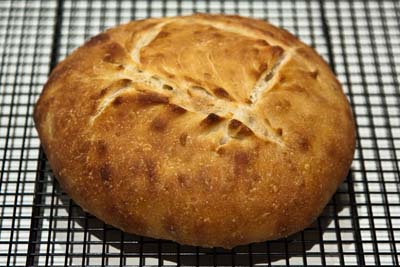
And finally, after more than a week of fiddling with flour, I baked my very first sourdough bread. Fresh from the oven (well, almost - Reinhart cruelly and correctly advises to wait a while before cutting into the loaves) it was wonderfully crusty on the outside and soft and sour on the inside. I had a loaf to take with me on our never-ending holiday road trip, and another loaf to tuck away in the freezer. Next on the agenda, I’ll need to see about refreshing my barm and trying some of the other sourdough recipes in the book.